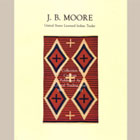NAVAJO RUGS FROM CRYSTAL TRADING POST ca. 1920-1940
June 03, 2016 until August 06, 2016
Opens at the gallery on Friday evening, June 3rd with a reception from 5 to 7 pm.
Crystal Trading Post gained its reputation at the end of the 19th century when trader J. B. Moore purchased the post and set about to be a career Navajo trader. Because the weather in the Chuska Mountains, where the post was located, was severe in the wintertime, few visitors ever showed up so Moore decided to create a mail order business with Navajo arts and crafts.
To make his mail order business work, Moore created a full-color mail order catalog in 1903 featuring Navajo rugs, jewelry, and miscellaneous objects. It apparently was successful, so in 1911, he published his second catalog. The combination of the two catalogs featured 31 Navajo rugs from which a client could order by mail and Moore would select the appropriate Navajo weaver to make the rug according to the size, quality, and price specified by the client. He also advertised jewelry, tableware, baskets and other art objects which also could be ordered.
In 1987, the publishing division of Adobe Gallery put together the old J. B. Moore mail order catalogs and published them as a new publication. As a natural follow-up to that, the gallery staff decided to search for a rug from each of the 31 illustrations in the catalog. It took several years, but when the collection was completed, a client purchased the entire group.
The rugs in this exhibit are not from the catalog examples, but from the 1920s to the 1940s, the period after Moore left the post and moved to California. Some of the same general design elements were retained by the weavers and new ones were introduced. Change came slowly to the weavers so many of the Moore designs can be seen in the textiles in this exhibit. It was not until the 1960s when the last vestiges of Moore’s influence on Navajo weaving ended.
What is the Whirling Log Symbol? The swastika - or "svastika" from the ancient Sanskrit language - is one of our most universal and positive symbols. Literally it means "auspicious mark", but in various cultures it has signified well-being, highest perfection, happiness, pleasure or good luck.
Reference books to add to your library:

![The Swastika Symbol in Navajo Textiles [2nd Edition] The Swastika Symbol in Navajo Textiles [2nd Edition]](https://www.adobegallery.com/uploads/book-swastika-thumb.jpg) ← J. B. Moore: United States Licensed Indian Trader - The Catalogues of Fine Navajo Blankets and Rugs (click for details)
← J. B. Moore: United States Licensed Indian Trader - The Catalogues of Fine Navajo Blankets and Rugs (click for details)
The Swastika Symbol in Navajo Textiles (click for details) →


